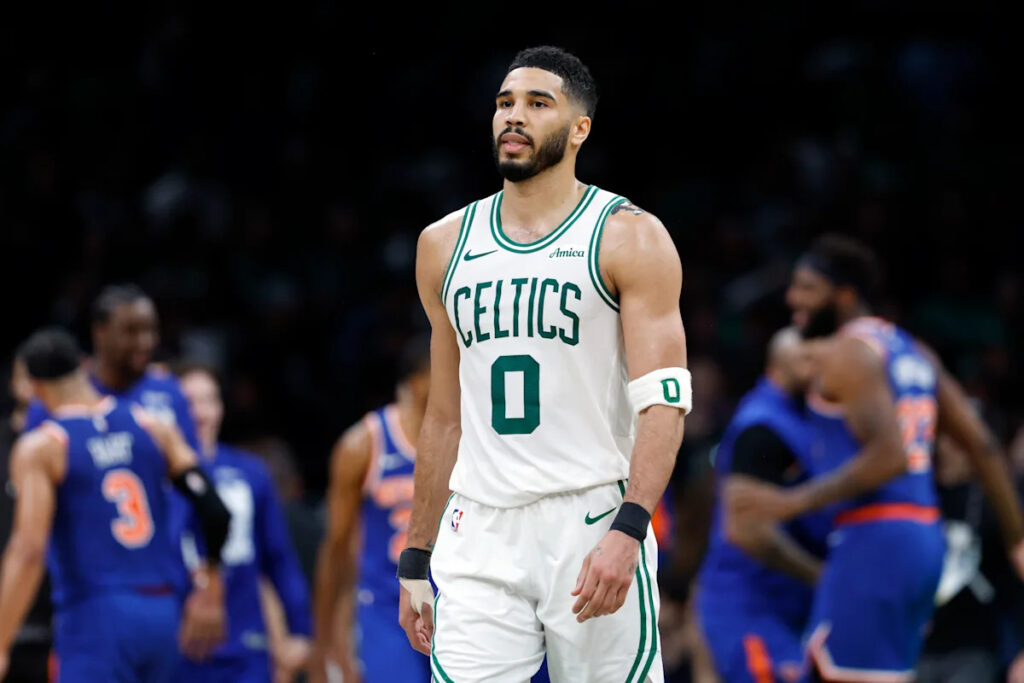The first step toward your opponent missing an NBA-playoff-record-setting number of 3-pointers is giving up, like, a ton of 3-pointers.
This, to be clear, was not the New York Knicks’ goal in Game 1 of the Eastern Conference semifinals.
Advertisement
“I don’t think you want to force them into 3s,” Knicks forward Josh Hart told reporters after the game. “We don’t want them to shoot more 3s. They got great shooters. We just tried to make it tough for them, play physical and do those kind of things. You never want a team like that to shoot more 3s. We were trying to take away 3s and they still got up 60.”
That the Boston Celtics only made 15 of the 60 played a major role in New York being able to erase a 20-point deficit and send the game to overtime, where a phenomenal extra-session effort spearheaded by Mikal Bridges led the Knicks to a 108-105 upset victory. It also invited the question that’s hung over the series between the final buzzer on Monday and the opening tip of Game 2 on Wednesday: Was that bad Celtics shooting, good Knicks defense, or a bit of both?
The answer, as usual, probably lies in the eye of the beholder.
NBA.com’s tracking data says that Boston went 7-for-32 on 3-pointers taken with a New York defender between 4 and 6 feet away from the shooter, and 7-for-24 on triples with at least 6 feet of space between the shooter and the closest Knick. But that, too, lies in the eye of the beholder, because when you go back and watch the Celtics’ long-ball launches, you don’t see 56 open looks; in fact, another page on the league’s stat site credits the Knicks with contesting 24 of Boston’s 3-pointers in Game 1.
Advertisement
Reasonable evaluators can disagree about what constitutes a good look or a bad look, and a hard contest or a soft one. While “reasonable” might not always be an adjective attached to the eminently quotable Joe Mazzulla, the Celtics head coach felt pretty positive about his team’s attempts on the whole.
“To me, I look at the process and the shot quality,” Mazzulla told reporters after Game 1. “So our shot quality was high. The points in the paint were even. We shot one more layup than they did. We shot 10 non-paint 2s. They shot much more than that. So you have to take a look at the process of what we’re trying to accomplish, and we were able to accomplish good results, for the most part.”
The numbers bear out Mazzulla’s view.
According to PBP Stats’ shot quality model, which considers a slew of factors — shot distance, shot angle, time-and-score in the game, whether the possession started off of a dead ball or a live one, etc. — but doesn’t factor in the identity of the shooter or defender distance, the Celtics’ expected effective field goal percentage in Game 1 was 53.2%, a roughly middle-of-the-pack mark in this postseason. Their actual effective field goal percentage in Game 1: 42.8% … which is their second-worst shooting performance of the season, and one of their dozen worst in the last four years.
Advertisement
Synergy Sports’ shot quality tracking model does factor in defender distance, as well as some of those other time/score/situation elements, in determining the expected points per shot (PPS) on a given attempt. The Celtics’ Game 1 Synergy shot quality: 1.07 expected PPS. Their actual PPS: 0.86. That -0.21 gap between expectation and reality represents Boston’s worst shot-making outing of the season, and its worst since a December 2022 loss to the Pacers that saw the C’s shoot just 38.6% from the floor.
The Knicks, on the other hand? Worse average shot quality, per both PBP Stats and Synergy, but better shooting efficiency. Make-or-miss league, and all that.
“Look at the process,” Mazzulla said after Game 1. “Whether you win or lose, there are possessions you have to get better at. Me and the staff, I’ll get better at the things we need to. We’ll look at the attention-to-detail stuff, and we’ll look at the process of what we did, and see where we need to get better.”
Advertisement
Mazzulla mostly echoed those sentiments at Tuesday’s Celtics practice, saying that with the exception of “10 or 11 you could probably take back,” he “loved the vast majority” of Boston’s 3-point attempts — and, evidently, got a kick out of fielding questions about the way his team’s offense generated shots that missed, while the Knicks’ approach generated ones that went down:
One “duality” that Mazzulla might not love quite as much: The split between how many of Boston’s shots from beyond the arc came on the move and off the dribble rather than off the catch.
During the regular season, the Celtics averaged 30.7 catch-and-shoot 3-pointers per game, second-most in the NBA, and made a scorching 39.1% of them. That was nearly twice their nightly volume of pull-up triples: 16.8 per game, which they converted at a notably chillier 33% rate. That balance mostly held across four regular-season matchups with New York: 30 catch-and-shoot looks, knocked down at a 43.3% clip, compared to 17.8 pull-up attempts, splashed 43.7% of the time.
Advertisement
In Game 1, though? More pull-up 3s than catch-and-shoot tries, with Boston’s shooters frequently firing on the move rather than with their feet set:
“Some of [the shots] felt good, some felt like we maybe forced the issue,” Celtics All-Star Jaylen Brown told reporters. “Definitely our rhythm and our timing was a little bit off.”
That might’ve been, in part, because the Knicks opened the series with a curveball — defending Boston in a way they’ve rarely done under head coach Tom Thibodeau.
Thibodeau has long preferred playing drop coverage against pick-and-rolls over switching ball screens. While switching allows a defense to take away a ball-handler’s airspace and limit open pull-up jumpers, it can also allow the offense to hunt mismatches against specific opponents, and distort the defense by getting players out of their most familiar positions and responsibilities. Thibs largely eschews that, feeling much more comfortable with a scheme that ensures he’s got a big man sinking back to protect the rim and stay in position to finish a possession with a defensive rebound; according to Second Spectrum tracking data, the Knicks have finished in the bottom six in switch rate in all five of Thibodeau’s seasons at the helm, and last in the league twice.
Advertisement
The Celtics knew that, and exploited it across their regular-season matchups to generate pretty much whatever wide-open look they wanted. In Game 1, though, Thibodeau changed course, instructing his defenders — even center Karl-Anthony Towns and point guard Jalen Brunson, who’d dabbled with switching against Boston during the regular season — to switch virtually every ball screen and try to play straight up at the point of attack, with the wings on either side of the ball loading up in the gaps to try to deter drives and keep the ball out on the perimeter:
“It’s something that we’ve seen all year,” Celtics big man Al Horford told reporters. “And [the Knicks] haven’t done it.”
And now, they have. According to Jared Dubin of Last Night in Basketball, the Knicks switched the pick-and-roll more often in Game 1 than they had in any game all season, and allowed significantly fewer points per possession on those switches than they had in any of their previous high-volume switching contests.
Advertisement
Part of the reason for the success, perhaps? Frenetic closeouts from Bridges, Hart and OG Anunoby that turned some of what might’ve been even more open 3-pointers into more harried drives or passes:
“[When] switching, [you’re] trying to take away some of their 3s: catch-and-shoot, pick-and-pop 3s,” Hart told reporters on Tuesday. “[We are] making sure when we do switch that the guy is not on an island. He has two, three [teammates] behind him ready to help, ready to step up, and just make it difficult for them. It was good for us to go out there and execute defensively for the game plan.”
While the Knicks very clearly didn’t take away the Celtics’ 3s, they did have some success in getting Boston bogged down in one-on-one attacks that more often stalled on the perimeter rather than getting all the way into the teeth of the defense. The Celtics took just seven attempts inside the arc and six free-throw attempts in the second half, and generated only three offensive rebounds between the start of the third quarter and midway through the fourth. Limiting Boston to one shot played a huge role in the Knicks being able to whittle a 20-point lead down and put themselves in position to take the lead late.
Advertisement
“In those moments when the other team’s got momentum, we can’t just fire up 3s,” Brown said after Game 1. “We’ve got to get to the free-throw line, get to the paint, get to the basket, and then maybe the next 3-pointer feels a little bit better. We settled in the second half, a lot. It felt like they were daring us to shoot, they wanted us to shoot those shots.”
Hart insists that wasn’t the case, but the Knicks did want to keep Boston on the perimeter and out of the paint, where the C’s can collapse the defense, force help and leave openings outside, revving up the drive-and-kick game. They did want Brown and Jayson Tatum to see Bridges, Anunoby and Hart lurking in the gaps, decide not to drive and instead take a contested 3 over a long-armed defender. They did want the Celtics to feel so confident in their embrace of what is effectively an underdog strategy — hunt the higher-value shot at all times, time-and-score be damned, in pursuit of efficiency — that they continued to pound it despite being both an overwhelming favorite in general and, in the specific framework of the game they were playing, already up by 20 points.
With an advantage that large, you can afford not to maximize the expected points per shot of every trip; what you can’t afford to do is just stop scoring. Accepting the invitation to launch off-the-bounce 3s against closeouts and contests created the conditions where that could happen.
Advertisement
“That’s an abnormal game in terms of us shooting the basketball,” Brown said.
Maybe Game 2 brings a return to normalcy. Maybe this game script, if it were to unfold again, would wind up being just fine for the Celtics, who remain the favorite in the series, with multiple projection models still liking their chances of bouncing back to knock off the Knicks and advance to the Eastern Conference finals for the fourth straight season.
“If the open ones go in,” Mazzulla said, “we’re not having this conversation.”
But if the vicissitudes of 3-point-shooting variance break New York’s way again — if the switching and aggressive gap help once again keep Boston out of the paint, if the pull-ups stay dry and the offense stays stagnant — the conversation might not only continue, but take a pretty dire turn. The Celtics can absolutely shoot, and play, better than they did in Game 1. And with the prospect of an 0-2 hole sitting just 48 minutes away … well, they’d better.
“In a close game, in overtime in the playoffs at home, when you lose, it’s very easy to — for lack of a better term — create spiders and come up with 10, 12, things that you need to do better,” Mazzulla said. “But the hardest thing to do is the simplest thing to do, and it starts there.”
#Celtics #3point #shooting #woes #Knicks #curveball #affect #Boston

